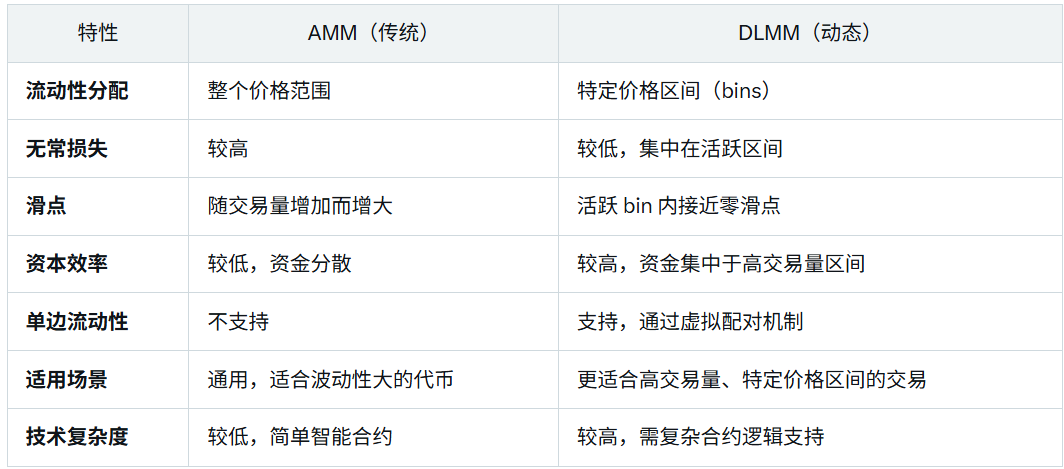Saros 2.0 is not just a DEX; it's a full-stack liquidity engine providing efficient, transparent, and composable infrastructure for users and liquidity providers (LPs), redefining the liquidity standards on Solana.
Features of Saros 2.0
1. Adopts DLMM (Dynamic Liquidity Market Maker) mechanism
2. Full-stack design
Saros 2.0 is not just a DLMM DEX, but also a
Token Factory & Launchpad, allowing anyone to issue tokens and create pools in seconds without approval
Auto-Pool Engine for Memecoins, automatically generating efficient liquidity pools for memes with one click
Spot + Perpetual Trading, sharing liquidity backend for spot and perpetual contracts
Mobile Superapp Integration, providing a one-stop experience on mobile
Saros 2.0 is building a new generation of Solana-native liquidity engines with a focus on fully on-chain + autonomous strategy + full-stack integration, meeting the needs for rapid deployment and strategy freedom in scenarios like memes, long-tail assets, and high-frequency trading.
DLMM vs. AMM: A Comparison of Decentralized Exchange Liquidity Mechanisms
DLMM (Dynamic Liquidity Market Maker) and AMM (Automated Market Maker) are core mechanisms used in decentralized exchanges (DEXs) to provide liquidity. They differ significantly in design philosophy, functional characteristics, and technical implementation. This article provides a detailed comparison of their working principles, advantages, disadvantages, and technical implementations.
1. Core Types and Features of Traditional AMMs
Traditional AMMs manage liquidity pools through smart contracts, replacing the traditional order book trading model. Based on their function design, AMMs can be categorized into the following main types:
1.1 Constant Product Market Maker (CPMM)
Representative projects: Uniswap, Bancor
Working principle: Based on the formula x * y = k, where x and y are the reserves of two tokens, and k is a constant. Token prices are determined by the ratio of tokens in the pool.
When the supply of token X increases, the supply of token Y must decrease to keep k constant.
Advantages:
- Simple and efficient, allowing users to interact directly with the liquidity pool without needing an order book.
- Supports trading of any token pair.
Disadvantages:
- Impermanent Loss (IL): Liquidity providers (LPs) may incur losses during price fluctuations.
- Low capital efficiency, as liquidity is spread across the entire price range.
1.2 Constant Sum Market Maker (CSMM)
Working principle: Fixed price, similar to traditional fixed-price orders.
Disadvantages:
- Traders and arbitrageurs may deplete the reserves of one token in the pool, causing liquidity imbalance.
- Liquidity pools may concentrate on a single asset, losing normal trading functionality.
1.3 Constant Mean Market Maker (CMMM)
Representative project: Balancer
Working principle: Allows multiple token combinations with adjustable weights, but still based on a function similar to CPMM.
Disadvantages:
- Does not completely solve the impermanent loss problem.
- Higher complexity, suitable for specific scenarios.
1.4 Hybrid CPMM (Stableswap)
Representative projects:
Working principle: Combines CPMM and CSMM to optimize stablecoin trading (e.g., USDT/DAI/USDC).
Advantages:
- Reduces slippage, suitable for assets with low price volatility.
Disadvantages:
- Limited to stablecoins or assets with highly correlated prices, not applicable to highly volatile tokens.
2. DLMM: A New Generation of Market Maker Mechanism
DLMM (e.g., Meteora on Solana) is an evolved version of AMM that adopts a concentrated liquidity model. It improves capital efficiency by allocating liquidity to specific price ranges (called "bins" or price slots). Here are the core features and technical implementations of DLMM:
2.1 Working Principle
Concentrated Liquidity:
- LPs can choose to concentrate funds within a specific price range (e.g., 0.95-1.05 USDC/SOL) rather than across the entire price range.
- Improves capital efficiency and reduces the waste of unused funds.
Bins (Price Slots) Mechanism:
- Each bin represents a fixed price range, and trades are executed at the bin's price, similar to limit orders.
- Example: If the current bin price is 1 USDC/SOL, traders buy SOL with USDC at a fixed price until the SOL reserves in that bin are exhausted.
- When a bin's liquidity is depleted, the system automatically switches to the next bin (e.g., price jumps to 1.01 USDC/SOL).
Dynamic Fees:
- Adjusts fees dynamically based on market volatility and trading volume to optimize LP returns.
Single-Sided Liquidity:
- LPs can provide liquidity with only one token (e.g., SOL), and smart contracts simulate traditional AMM token pairs through a "virtual pairing" mechanism.
- Example:
- Trader buys SOL with USDC: USDC enters the pool, and SOL is deducted from the bin's "virtual reserves."
- Trader buys USDC with SOL: SOL enters the pool, and USDC is deducted from the bin's actual reserves.
2.2 Technical Implementation
Smart Contract Management:
- Tracks token reserves in each bin in real-time.
- Updates bin reserves based on trade direction (buy/sell) and determines whether to switch to the next bin.
- Triggers events when switching bins to notify the front-end or off-chain systems to update prices.
On-Chain Order Book Experience:
- The segmented price mechanism of bins provides users with an experience similar to centralized exchange order books.
Dynamic Fee Calculation:
- Smart contracts adjust trading fees in real-time based on market conditions, balancing LP returns and trader costs.
2.3 Advantages
- Reduces Impermanent Loss:
- LPs provide liquidity only for specific price ranges, so large price fluctuations affect only a portion of funds.
- Zero Slippage Trading:
- Trades within active bins are executed at fixed prices, resulting in minimal or zero slippage.
- High Capital Efficiency:
- Liquidity is concentrated in high-trading-volume price ranges, improving fund utilization.
- Flexibility:
- Supports single-sided liquidity, lowering the entry barrier for LPs.
- Dynamic fee mechanisms optimize returns.
2.4 Disadvantages
- Risk of Liquidity Depletion:
- If trading volume is unbalanced (e.g., one-sided trading), a bin's liquidity may be depleted, causing trade suspension or price jumps.
- Contract Logic Complexity:
- Virtual token reserves rely on smart contract logic, requiring highly reliable contract design.
- Technical Barrier:
- Compared to traditional AMMs, DLMM implementation and usage demand higher technical expertise from developers and LPs.
Conclusion
Traditional AMMs (e.g., Uniswap, Balancer, Curve) achieve decentralized trading through simple mathematical functions (e.g., x*y=k), making them suitable for a wide range of token pairs but limited by impermanent loss and low capital efficiency.
DLMMs (e.g., Meteora) significantly enhance capital efficiency and LP returns through concentrated liquidity, price ranges (bins), zero-slippage trading, and dynamic fee mechanisms, while effectively reducing impermanent loss. Single-sided liquidity and on-chain order book experiences further enhance their flexibility.
Future Outlook: The complexity of DLMMs and their reliance on balanced trading volumes may limit their application in certain scenarios. However, their innovative design offers a more efficient liquidity solution for DEXs, especially in high-trading-volume markets. With the development of blockchain technology, DLMMs are expected to see broader adoption on more chains (e.g., Solana, Ethereum L2).

6.07K
0
The content on this page is provided by third parties. Unless otherwise stated, OKX is not the author of the cited article(s) and does not claim any copyright in the materials. The content is provided for informational purposes only and does not represent the views of OKX. It is not intended to be an endorsement of any kind and should not be considered investment advice or a solicitation to buy or sell digital assets. To the extent generative AI is utilized to provide summaries or other information, such AI generated content may be inaccurate or inconsistent. Please read the linked article for more details and information. OKX is not responsible for content hosted on third party sites. Digital asset holdings, including stablecoins and NFTs, involve a high degree of risk and can fluctuate greatly. You should carefully consider whether trading or holding digital assets is suitable for you in light of your financial condition.

